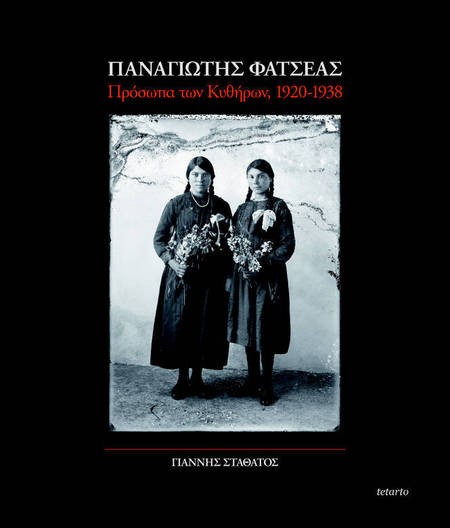PANAYOTIS FATSEAS: PROSOPA TON KYTHERON, 1920-1938
Author: Yiannis Stathatos
When Published: 2008
Publisher: tetarto editions, Athens
Available: Yes
ISBN: 978 960 87948 4 9
Description: Hardback 29.5x30 cm, 160 pp.
Illustrated monograph on the work of Panayotis Fatseas, the first Kytherian photographer. Includes 122 full-page duotone photographs, introductory essay and appendices.This is a Greek-language only edition, though the captions to the photographs are in both Greek and English. An English-language edition will be published later in 2008.
Retail price in Greece: 40 euros.
In AUSTRALIA, available from George Poulos (02) 93888320, and
Email, here
or Angelo Notaras, (02) 9810 0194, and
Email, here
at the subsidised price of AU$55.00

Arising from an exhibition at the Benaki Museum
Panayiotis Fatseas’s portraits from bygone era went on display at Benaki Museum’s Pireos Street Annex, which presented a selection of images taken by this ‘recently discovered’ Kytherian photographer.
In the first decades of the 20th century, the families of Kythera that wanted to have photographic portraits taken would most likely have gone to the studio of Panayiotis Fatseas, a self-taught photographer gifted with a talent for capturing his sitter’s gaze and personality in lively, non-academic portraits. The photographs that Fatseas took on this island off the eastern tip of the Peloponnese documented the most important moments in the lives of the local inhabitants: the weddings, formal events, the birth of a new child, both happiness and grief. His clients also included the families that had emigrated to either the United States or Australia; their request was to have photographs of their relatives, still back home, sent to them.
From 1920 until his untimely death in 1938 – he was only 50 – Fatseas produced a substantial body of work, only recently discovered and now appraised as an important chapter in the history of early Greek photography. This is thanks to Yiannis Stathatos, a photographer, curator and writer on photography (and the person behind the Kythera Photographic Encounters), the person who located and undertook the study and conservation of the Panayiotis Fatseas archive (around 2,200 glass negative plates) and brought it to the attention of both specialists and the general public.
A selection of Fatseas’s photographs were first presented during one of the Kythera Photographic Encounter events a few years ago. “Panayiotis Fatseas, Faces of Kythera, 1920-1938,” an exhibition that was stagewd at the Pireos Annex of the Benaki Museum, and which made his work known to the Athenian public. The exhibition was organized by the Kythera Photographic Encounters and the Photography Archive of the Cultural Society of Kythera to which the Fatseas archive was donated in 2002 in collaboration with the Photographic Archives of the Benaki Museum. It is supplemented with a catalog on the artist’s work.
Stathatos, curator of the exhibition, notes that one of the unique aspects in the photography of Fatseas is its lack of rigidity, the ease and naturalness in the poses and the vividness in the expressions of the sitters. Fatseas did not photograph frozen postures or void expressions but had a rare capacity for bringing out the distinctive personality of each person. Portraiture comprises the majority of his work; however there were also some pictures of landscapes and outings.
Most of the photographs were taken in his studio, which was set up around 1920; the building is still preserved. It is most probable that Fatseas was the first inhabitant on Kythera to own a photographic camera. He had purchased it in New York where he emigrated to at the age of 23 and lived for two years, working as a waiter. He returned to Greece in 1912 in order to fight in the Balkan wars. The huge demand for portraits made him turn to photography, yet Fatseas also worked in agriculture and commerce for a short period.
Two of his sons took up the trade and ran their father’s photographic studio for another four decades after the photographer’s death. They also expanded its activities by incorporating a summer cinema. However, the archive of Fatseas remained hidden for years. Aided by Fatseas’s grandson, Stathatos has saved the archive from destruction and made a new valuable addition to the history of Greek photography.
“Panayiotis Fatseas, Faces of Kythera, 1920-1938” was staged at the Pireos Annex of the Benaki Museum, 138 Pireos Street, Athens, tel 210 3453111.
http://grhomeboy.wordpress.com/tag/museums/page/3/